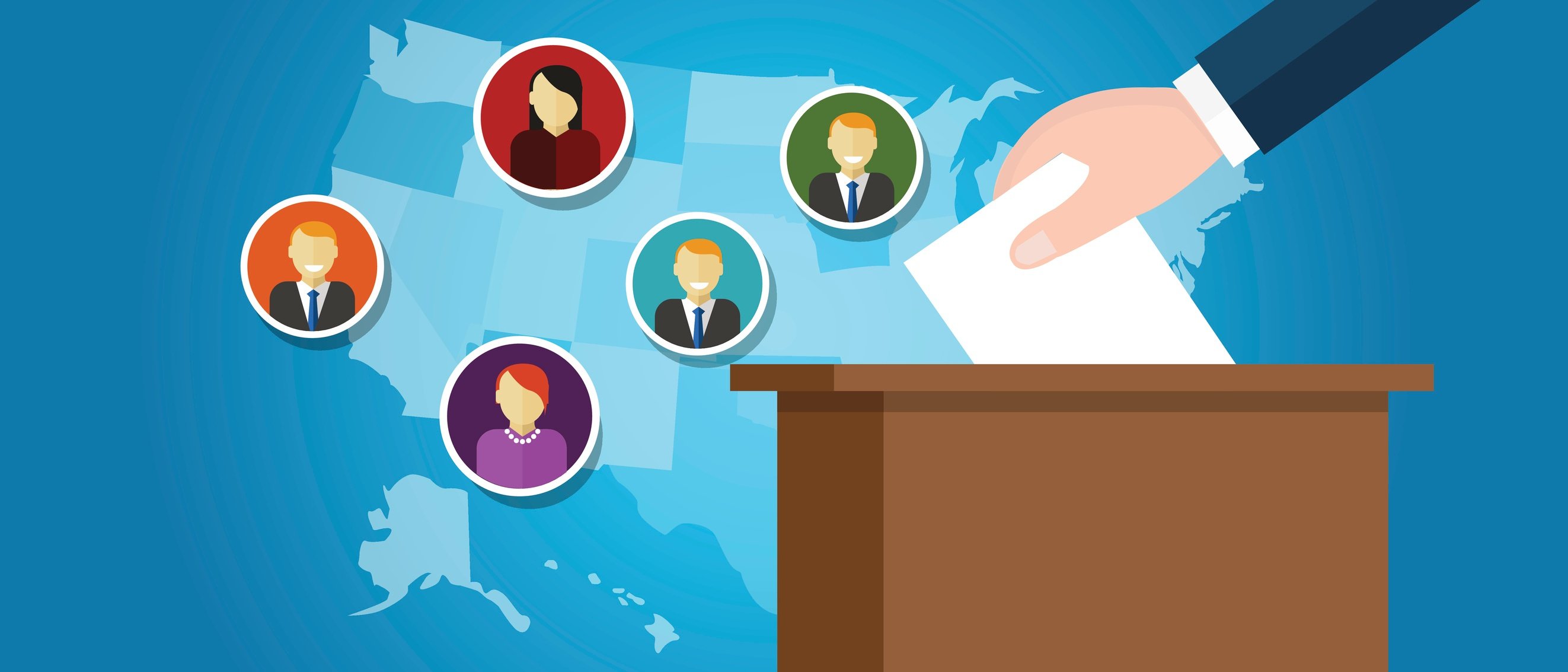Reaching the age of 18 is an exciting milestone. Now, as legally-recognized adults, each year brings with it a new generation of voters poised to influence the path of their local, state, and federal governments. For politically-conscious teens, however, exercising this new right of self-government can occasionally bring with it some challenging questions. For example, how can a candidate win an election despite receiving fewer votes than their opponent? How do some relatively small states carry substantial influence in national elections? Why can some people vote and not others?
Ultimately, most of these democratic peculiarities boil down to a single phenomenon: the Electoral College. Below, we’ll provide a primer on the function of the electoral college, the relatively unique history behind the American system of voting, and, most importantly, what it means for new generations of young voters.
Along the way, we’ll also explore a few common myths about our nation’s unique voting system, as well as some new ideas being offered to address some of our system’s oddities.
Let’s dig in.

Electors & The Electoral College
In the vast majority of democratic nations, elections are typically decided by majority vote—that is, whoever gets the most votes, wins. In the United States, however, we approach the system a bit differently. Rather than tallying the direct majority of votes, we grant a certain number of “electoral” votes to each state. Wyoming, for example, carries a modest three electoral votes; California, on the other hand, boasts a seemingly impressive 55.
These “votes” are not really votes, however; in fact, these votes are actually people. Each state appoints a certain number of “Electors” in proportion to the electoral votes that state carries. After a state’s ballots are tallied, the results are delivered to these Electors, who then cast their respective vote for the election. In many cases, these Electors do indeed follow the will of their state’s voters. However, in 24 states, Electors are not actually required to do so. In nearly half of our states, Electors can and do, cast their vote for whomever they wish.
Big vs. Small States
While the disparity in state electoral votes may at first appear to be greatly unfair to a small state like, say, Montana, in reality, states with lower populations are actually getting a fantastic deal. Let’s do the math!
Wyoming boasts a population of roughly 400,000 voters. With three electoral votes, this means Wyoming residents carry about 1 vote per 130,000 people. California, on the other hand, is massive; in fact, California now boasts more registered voters than 46 states combined! Unfortunately for California, even with 55 electoral votes, this means California residents carry only 1 vote per approximately 400,000 people.
This means that, mathematically, the impact of a single Wyoming voter’s ballot is the same as about three California ballots. Weird, right?
“Swing” States
This imbalance leads to the existence of “swing” states—the handful of seemingly random states the news media eyes with ferocity as election night ticks down to its dramatic conclusion. Unfortunately, while this dynamic may make election night that much more exciting (or depressing) for viewers, it is also the result of a serious democratic imbalance. In fact, experts on election reform in the United States estimate that up to 80% of all votes cast in our presidential elections have zero impact on the outcome of the race.
While the voices of swing state residents like Ohio and Florida are certainly important, this also means that candidates can effectively ignore the vast majority of American voters on the campaign trail. This imbalance has also led to the popular conception of “red states” vs “blue states” which, as we’ll see below, could not be further from the truth.
Red vs. Blue (Actually, We’re Purple)
Many Americans, including the media, labor under the idea that the United States is split among two distinct, identifiable political groups. In reality, the idea of a “red” or “blue” state is fiction. In 2012, for example, over 3 million Texas residents voted Democratic; likewise, over 5 million California residents voted Republican.
To help visualize this: If the United States awarded electoral votes proportionally, in the 2012 Presidential election, 16 of Texas’ electoral votes would have gone to the Democratic candidate, while a whopping 20 of California’s 55 votes would have gone to the Republican.
Across virtually all states, Americans represent every corner of our political spectrum. Unfortunately, due to the oddities of our electoral system, Americans representing minority political views in their state are effectively invisible. While some individuals may present the narrative that Americans belong to one of two bitterly-gridlocked camps, this is just not true. Americans are tremendously diverse in their political beliefs, and the apparent gridlock of the “red vs. blue” electoral system is simply the result of the way our electorate functions.
This dynamic unfortunately also promotes the less-than-democratic practice of gerrymandering, which we will explore in detail below.
Gerrymandering
One of the most powerful tools available to political parties in the United States is gerrymandering. Gerrymandering is essentially the practice of using the electoral system to determine the outcome of an election before ballots are cast.
Every decade or so, politicians redraw the districts in each state that determine representatives in House and State legislatures. Each voter in the United States lives in one such district, which determines that region’s representation in the legislature. The tricky part is, these districts are not determined by voters, nonpartisan committees, or otherwise uninterested parties. Instead, voting districts are drawn by the very same politicians who hold and/or run for offices those same districts are responsible for electing.
To help visualize this issue, imagine a fictional city with five neighborhoods. Two of these neighborhoods are strongly in favor of the color pink, and overwhelmingly vote pink in every election. The three adjacent neighborhoods, however, adore the color green, and proudly vote green every year. Ordinarily, each neighborhood would elect its own representative, likely resulting in two pink officials and three green officials.
However, now say the green officials get to redraw the districts of the city, and decide the districts will no longer cover each neighborhood squarely. Instead, a small piece of each pink neighborhood will be taken and lumped into a district with a large piece of each green neighborhood. The result is five oddly-shaped districts, each with a little bit of pink and a large amount of green. When it comes time to vote, this means that every district will likely result in a green win.
Despite both examples having the exact same amount of voters, living in the same locations, we now have five green officials and zero pink, rather than the relatively proportional representation of the first example. Clearly, this practice is less than democratic, leading numerous candidates, election reform organizations, and political watchdog groups to campaign for enhanced protections against gerrymandering.
With the exception of France, the United States is the only country in the world with this manner of electoral system. Which begs the question, how exactly did our unique electoral system come to be?
Founding of The College
To get an idea of how we ended up with such an odd electoral system, we’ll have to jump way back in time to 1776. The Founding Fathers, tasked with building a brand new system of government from the ground up, certainly had a formidable obstacle to surmount. Many of the Founders expressed concern at the possible dangers of direct democracy. Putting total electoral power into the hands of brand-new Americans at the turn of a new nation’s founding simply seemed too risky.
Strangely enough, despite the disparity in electoral votes per populace in the United States today, some of the most outspoken critics of a direct democratic system during the founding were the larger states. Many of these states, wanting a greater share of democratic power due to their populations, would not have benefited from a direct democracy because a large percentage of their populace could not vote: They were slaves.
In order to successfully found a United States of America, the Founders were required to make concessions to maintain the integrity of the states. As a compromise, the Founders decided to create the Electoral College. In doing so, the Founders hoped to create a “buffer” of sorts between the direct rule of voting Americans and the will of the nation’s early governors, while also appeasing the conflicting ideas of different states.
Nearly two-and-a-half centuries later, this system is still in effect. While our nation has evolved greatly in that time, the legacy of the Electoral College is, nonetheless, rooted in tradition that is less than democratic.
Changing the Electoral System
This has not, however, kept Americans from nurturing democracy. During the Founding, only 6% of Americans could even vote in elections. It took nearly a century-and-a-half to incorporate African Americans, women, and men that did not own land. Today, the only requirement to participate in elections is to reach the age of 18.
However, there are some exceptions to this rule being hotly contested by election reformers. In fact, several million American citizens, despite paying taxes, are not granted the right to vote. Citizens of United States territories, for example, do not participate in national elections, and citizens of Washington D.C., despite the capital being home to over 600,000 Americans, do not receive representation in Congress.
In addition, one of the largest groups of Americans who still do not possess the right to vote are felons. Many felons are barred from voting for life, even after serving out their sentence.
Why Can’t Felons Vote?
Barring convicted felons from participating in elections is not, as some think, simply a penalty for breaking the law. Rather, this practice originated in the “Jim Crow” laws of the Southern United States. Despite being granted the right to vote, African-American citizens encountered a variety of obstacles in an attempt to prevent the newly-freed slaves from voting. One of the most effective tools available to opponents was the criminal justice system. During this time, many forms of otherwise-minor misdemeanor crimes were re-classified as felonies, and subsequently punished with revocation of voting rights.
Unfortunately, despite progress in Civil Rights nationwide, this legacy still prevents a large number of Americans from voting, as even non-violent crimes often result in permanent revocation of voting rights. This is, however, a very outspoken concern for election reform organizations, and numerous states have followed suit in rolling back some of the nation’s historic obstacles to democratic participation.
So Why Is It Important to Vote?
We’ve explored some aspects of our electoral system that can cause frustration, confusion, or, worse, apathy. However, despite these characteristics, it is more important than ever for individuals wishing to promote positive change in the system to participate.
While the Founding Fathers may have given us a system that is in many ways imperfect, vulnerable to abuse, or may leave many voters feeling unheard, it is also a system that has seen dramatic evolution in what is, compared to other nations, an extremely short lifespan. The nature of our democracy is that it can be improved through participation, as we’ve seen in numerous examples above,. Furthermore, the defects we may wish to change are the very defects that can be resolved through democratic efforts.
We’ve further seen that, despite what some commentators may assert, Americans as a group are not nearly as different or divided as one might think. In actuality, we are a nation of remarkably independent, free-thinking participants, and the color of our cities, states, or ballots is far more a reflection of our electoral structure than of our individual thoughts, beliefs, or communities.
By understanding the history of our electoral system, its function in the present day, and openly acknowledging its flaws, we are exemplifying the best attributes of a free, democratic republic, and well on the way to improving our own system of self-government.
No democracy is perfect, either in practice or in its history. Ours is, however, uniquely American and, as history has shown, uniquely capable of improvement through our own individual actions.






